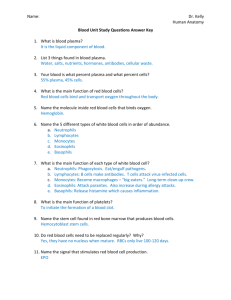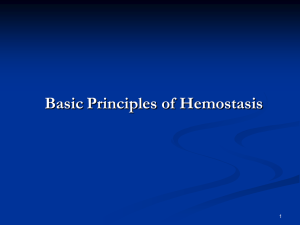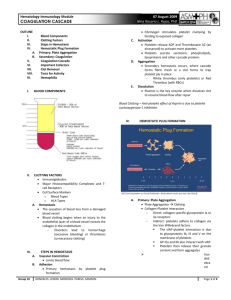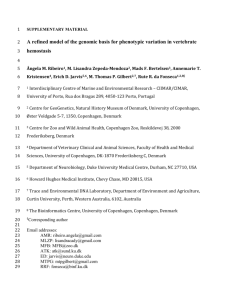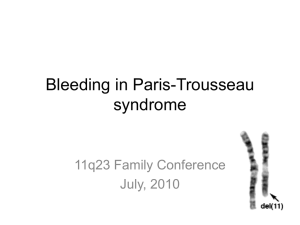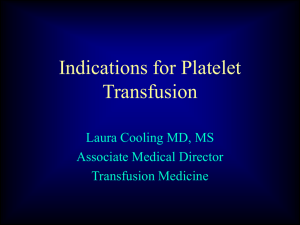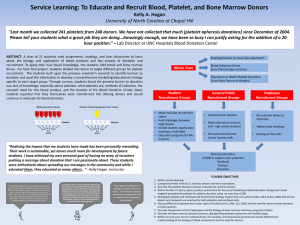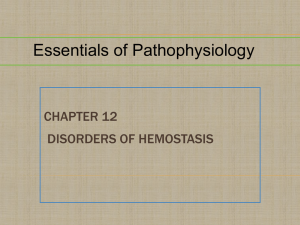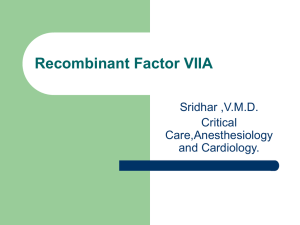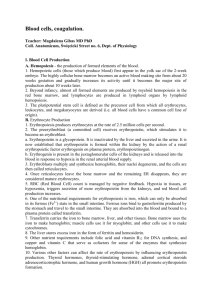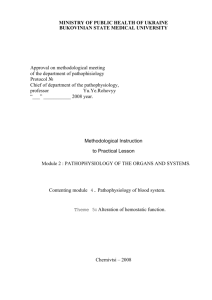Chapter 16
advertisement
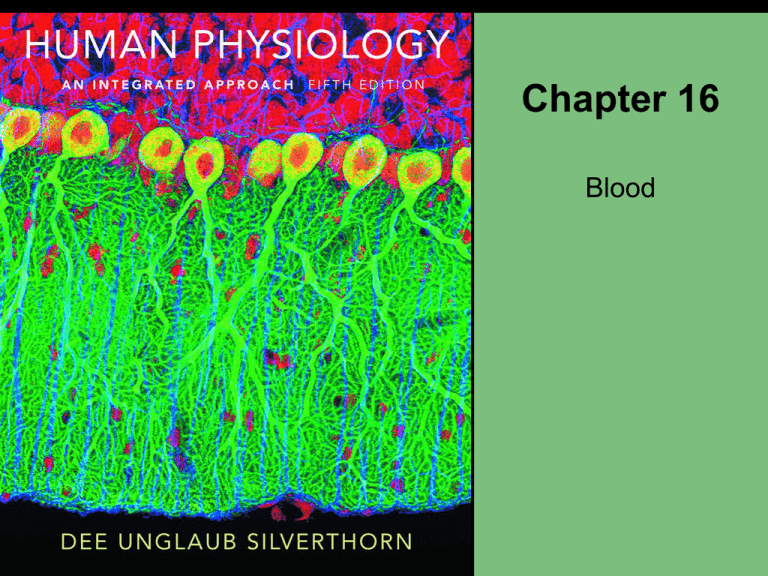
Chapter 16 Blood About this Chapter • • • • Plasma and the cellular elements of blood Blood cell production Red blood cells Platelets and coagulation Composition of Blood Water Amino acids Albumins Proteins Globulins Glucose Fibrinogen Ions BLOOD is composed of Plasma Organic molecules such as Lipids Trace elements and vitamins Nitrogenous waste CO2 Gases such as O2 Figure 16-1 (1 of 2) Composition of Blood Lymphocytes Red blood cells Monocytes BLOOD is composed of Cellular elements White blood cells include Neutrophils Platelets Eosinophils m 0 5 10 Basophils 15 Figure 16-1 (2 of 2) Plasma Proteins Table 16-1 Cellular Elements • Three main cellular elements • Red blood cells – also called erythrocytes • Platelets – split off from megakaryocytes • White blood cells – also called leukocytes • Lymphocytes – are also called immunocytes • Monocytes – develop into macrophages • Neutrophils – neutrophils along with monocytes and macrophages are known as phagocytes • Eosinophils – eosinophils along with neutrophils and basophils are also called granulocytes • Basophils – tissue basophils are called mast cells Hematopoiesis Pluripotent hematopoietic stem cell BONE MARROW Uncommitted stem cells Committed progenitor cells Lymphocyte stem cells Erythroblast Megakaryocyte Figure 16-2 (1 of 2) BONE MARROW Hematopoiesis Erythroblast CIRCULATION Megakaryocyte Reticulocyte Erythrocyte Platelets Neutrophil Monocyte Basophil Eosinophil Lymphocyte Figure 16-2 (2 of 2) Blood Cells Table 16-2 Clinical Tests • Hematocrit: ratio of red blood cells to plasma MALES FEMALES 40%–54% 37%–47% 14–17 12–16 4.5–6.5 x 106 3.9–5.6 x 106 4–11 x 103 4–11 x 103 Neutrophils 50%–70% 50%–70% Eosinophils 1%–4% 1%–4% <1% <1% 20%–40% 20%–40% 2%–8% 2%–8% 150–450 x 103 150–450 x 103 Hematocrit Hemoglobin (g Hb/dL* blood) Red cell count (cells/µL) •58% plasma volume Total white cell count (cells/µL) Differential white cell count Basophils 100% Lymphocytes <1% white cells Monocytes Platelets (per µL) *1 deciliter (dL) = 100 mL 42% packed red cell volume Figure 16-3 Focus on … Bone Marrow Bone marrow (a) Figure 16-4a Focus on … Bone Marrow Bone cortex Central sinus Stroma of marrow Venous sinuses Radial artery Nutrient artery (b) Figure 16-4b Focus on … Bone Marrow Mature blood cells squeeze through the endothelium to reach the circulation. Stem cell Platelets Mature neutrophil Reticulocyte expelling nucleus Fragments of megakaryocyte break off to become platelets. Reticular fiber Reticular cell Stem cell Venous sinus Macrophage Monocyte The stroma is composed of fibroblast-like reticular cells, collagenous fibers, and extracellular matrix. Lymphocyte (c) Figure 16-4c Red Blood Cells Cytoskeleton filament Attachment protein (a) SEM shows biconcave disk shape of RBCs. (b) Cross section of RBC Actin (c) The cytoskeleton creates the unique shape of RBCs. Figure 16-5 Osmotic Changes to Red Blood Cells • The disk-like structure of red blood cells allows them to modify their shape in response to osmotic changes Figure 16-6 Iron Homeostasis and Metabolism Iron (Fe) in diet 1 Iron comes from the diet. 1 Intestine Plasma Fe 3 Fe・transferrin 2 Bone Marrow Fe 5 Heme Hb RBC synthesis 2 Fe absorbed by active transport. 3 Transferrin protein transports Fe in plasma. RBC Hb 4 Liver stores excess Fe as ferritin. Spleen Old RBCs destroyed Hb 5 Bone marrow uses Fe to make hemoglobin (Hb). 6 Bilirubin Liver 8 Bile Bilirubin metabolites in feces 7 4 Ferritin Bilirubin metabolism 6 Spleen converts Hb to bilirubin. Kidney Bilirubin + metabolites 7 Liver metabolizes bilirubin and excretes it in bile. 8 8 Bilirubin metabolites are excreted in urine and feces. Bilirubin metabolites in urine Figure 16-7 Red Blood Cells • Live for about 120 days • Hemoglobin components are recycled • Amino acids are incorporated into new proteins • Some iron from heme groups reused in new heme groups • Remnants of heme groups are converted to bilirubin, then excreted as bile • Jaundice results from elevated levels of bilirubin Red Blood Cells Table 16-3 Sickled Red Blood Cells • Morphology can provide clues to the presence of disease Figure 16-8 Platelets Form from Megakaryocytes Megakaryocytes are giant cells with multiple copies of DNA in the nucleus. The edges of the megakaryocyte break off to form cell fragments called platelets Platelets Endoplasmic reticulum Red blood cell (a) Figure 16-9a Overview of Hemostasis and Tissue Repair Damage to wall of blood vessel 1 Vasoconstriction Collagen exposed Tissue factor exposed Platelets adhere and release platelet factors Coagulation cascade 2 Thrombin formation Platelets aggregate into loose platelet plug 3 Temporary hemostasis Clot: reinforced platelet plug Converts fibrinogen to fibrin Fibrin slowly dissolved by plasmin Cell growth and tissue repair Clot dissolves Intact blood vessel wall Figure 16-10 Platelet Plug Formation 1 Exposed collagen binds and activates platelets. Lumen of blood vessel 3 Prevents platelet adhesion Intact endothelium 2 Release of platelet factors 3 Factors attract more platelets. 4 2 Releases prostacyclin and NO 4 Platelets aggregate into platelet plug. 1 Smooth muscle cells Collagen subendothelial layer Exposed collagen in damaged blood vessel wall ECF Figure 16-11 Clotting Process Table 16-4 The Coagulation Cascade INTRINSIC PATHWAY XII EXTRINSIC PATHWAY Collagen or other activators Damage exposes tissue factor (III) Active XII VII XI Ca2+ Active XI Tissue factor (III) and active VII IX Ca2+ positive feedback Active IX VIII Ca2+ X phospholipids (PL) Active X COMMON PATHWAY Prothrombin Ca2+, positive feedback Thrombin V, PL Fibrinogen XIII Fibrin Active XIII Ca2+ Cross-linked fibrin Figure 16-12 Coagulation and Fibrinolysis Coagulation Clot Thrombin Fibrinolysis Plasminogen tPA Fibrinogen Fibrin polymer Plasmin Fibrin fragments Figure 16-13 Coagulation Table 16-5 Coagulation Table 16-6 Coagulation Figure 16-14 Summary • Plasma and cellular elements • Plasma, red blood cells, white blood cells, platelets, and megakaryocytes • Plasma proteins and their functions • Five types of white blood cells • Blood cell production • Hematopoiesis and cytokines Summary • Red blood cell • Transferrin, ferritin, bilirubin, bile, and jaundice • Platelets and coagulation • Hemostasis, platelet plug, platelet adhesion, platelet aggregation, and fibrin • Coagulation cascade, fibrinogen, thrombin, plasmin, prostacyclin, and anticoagulants

